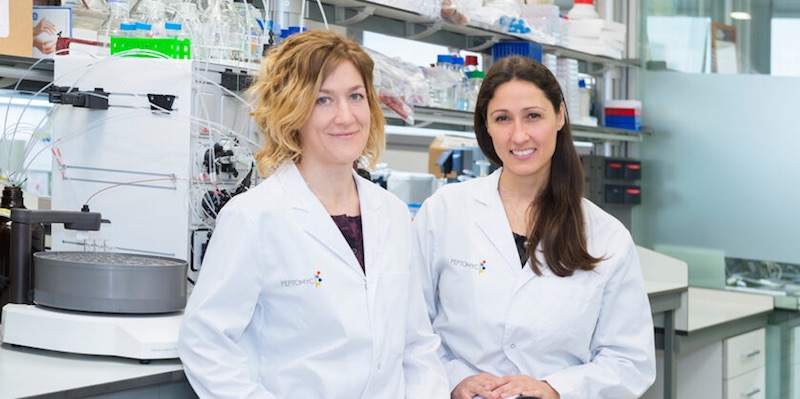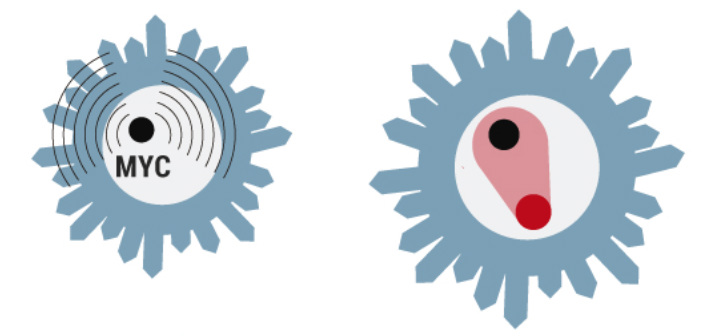The ultimate goal of cancer research is to bring to the market a drug that improves the treatment of patients lacking options. Laura Soucek, CEO of the startup Peptomyc, shares the story of her journey to take a cancer treatment against an until now undruggable target to the clinic.
It all started when Soucek was a PhD student in Rome, over 20 years ago now. As a “naive and stubborn” student, she decided to challenge what the scientific community had long thought was impossible.
Soucek was studying a protein called myc. “It’s a protein that is present in all cells,” she explained, “but it is very clear that the cancer cells depend on it. Myc allows cancer cells to proliferate, to survive treatment, and to even be invisible to our immune system. So you can imagine that inhibiting myc could give us a huge therapeutic opportunity in cancer.”
However, myc was considered an undruggable target. For one, its 3D structure makes it difficult to design molecules that can inactivate it. The protein is also hidden inside the cell nucleus, which most drugs can’t reach. In addition, since myc is present in healthy cells, it was thought that blocking it would result in “catastrophic side effects.”
“This was actually a dogma in the field. Nobody had really tried to inhibit myc because of fear of the side effects,” said Soucek.
She has managed to prove these claims wrong. Encouraged by early results, she moved to San Francisco to test on mice a myc inhibitor she designed, called omomyc, with a one-year fellowship that ended up turning into 10 years. She then moved to Barcelona to study it in human tumors transplanted into mice at the Vall d´Hebron Institute of Oncology. There, 4 years ago, she founded Peptomyc.

Soucek started the company to transform her research into a treatment for cancer that is not only more effective than current options, but, most importantly, less toxic. “We see many patients that decide not to undergo therapy because of fear of the side effects that often come with current therapies,” explained Soucek.
In preclinical trials, omomyc has so far shown no side effects. One of the reasons behind it is that it is a protein drug, larger than the conventional small molecule drugs. Myc doesn’t have a fixed 3D-structure, meaning that a small molecule that can interact with myc will likely interact with many other proteins in the body, resulting in dangerous side effects. Omomyc, however, has a larger surface that makes the interaction much more specific. “It’s an approach I believe can be expanded to other undruggable targets,” said Soucek.
Omomyc also has the potential to act in multiple types of cancer given that many different cancer mutations depend on the activity of the myc protein. “The beauty of attacking myc is than in principle we could go in all types of cancer. It’s the opposite of personalized medicine,” she said. “We are not designing this therapy for 1% or 2% of the cancer population.”

However, as Soucek puts it, so far she’s become very good at curing mice, but that’s still very different from curing cancer in humans. Peptomyc is planning a phase I/II clinical trial to start in 2020. Once the drug has proven safe, the first indications it will be tested in are metastatic breast cancer and non-small cell lung cancer, which have some of the lowest survival rates.
More than 20 years after Soucek first conceived a drug against an undruggable target, clinical trials are finally on the horizon. To reach this point, she had to completely step out of her comfort zone.
“I had no business experience at all,” Soucek recalls. While still running her lab, she started attending business classes in the evenings and found an advisor. “Reading as much as possible, making mistakes, asking stupid questions… all those things, I’ve done them.”
She learned about valuation, market studies, and business models. She switched giving scientific talks with elevator pitches. “You have to be careful not to be too scientific, because that bores the investors to death. My strength was the science but I couldn’t talk about it too much!” She put together a team of experts that could fill the gaps where the scientific founders had weaknesses.
Her efforts paid off. In 2016, Peptomyc got €1M in seed funding. The following year it closed a €4.2M Series A round led by Alta Life Sciences, which was actually the first investment of this specialist VC firm in Barcelona.
Now, Peptomyc is seeking further funding to cover the full costs of its first clinical trial — the next step in Soucek’s journey to bring cancer patients a better alternative to current treatments. “The most meaningful changes in cancer treatment have come from discoveries made by basic scientists,” she reflected. “In the end it’s the ultimate objective of cancer research.”





